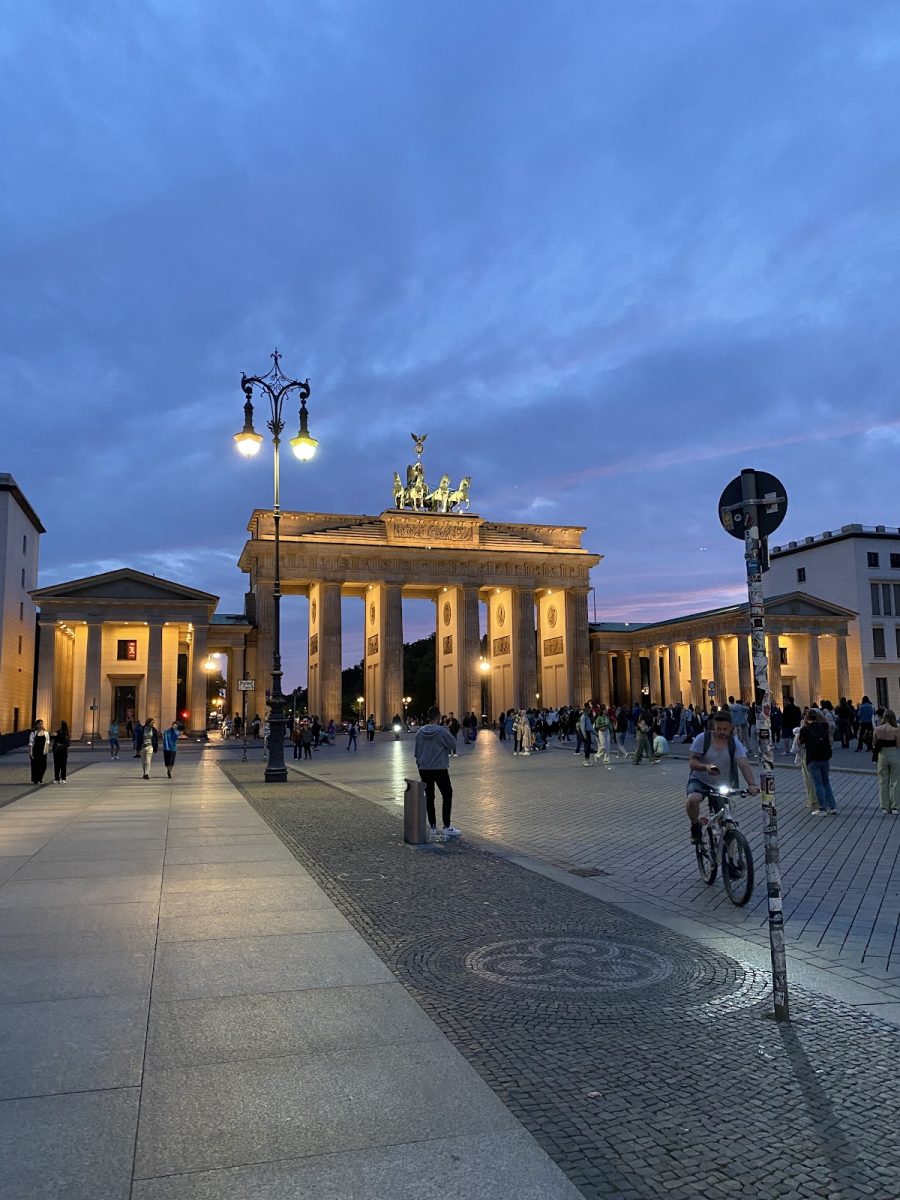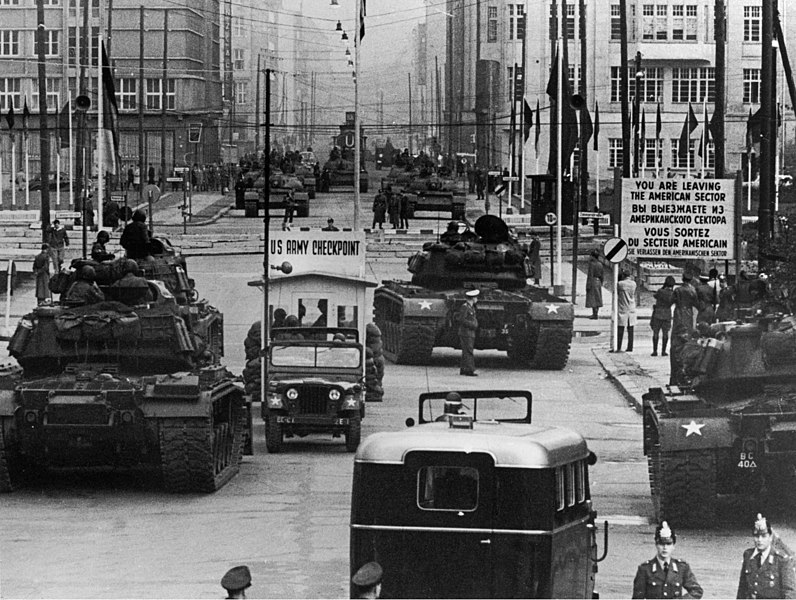In what was once a bleak strip of land where a looming wall stood, today people are free to stroll slowly through the grass of a lovely park where music plays and the warmth of the sun beams on their faces. A neighborhood that once had an air of claustrophobia and captivity is now a place for young people to enjoy a serene weekend.
Once the greatest site of conflict in the twentieth century, Berlin is now a thriving city of arts, nightlife, and youthful spirit. In no other city is such a barrage of tragic history — from the Nazis to the Cold War — acknowledged alongside a contemporary utopia.
This past August 2023, I had the fortunate experience of visiting this metropolis for four days. Here are some of the most fascinating spots across the city.
Brandenburg Gate
Before the birth of modern Germany in 1871, the German state of Prussia was one of Europe’s leading powers, with Berlin at the center. The Brandenburg Gate was commissioned by the Prussian emperor Frederick William II, and it was designed as a symbol of peace in the late 1700s, following years of war during the reign of the prior king, Frederick the Great.
The gate was again the location for a call for harmony in the 1980s. After World War II, a defeated Germany was divided into East Germany, controlled by the Soviet Union, and West Germany, controlled by the United States, France, and Great Britain. The city of Berlin itself, though situated fully in East Germany, was split into East and West as well. Tensions soon climbed high between the occupying powers of East and West Berlin with the rise of conflicting ideals of communism versus democracy.
Ultimately, barricades were constructed to divide each half of the city, and the Brandenburg Gate marked the border. Yet, neither East nor West Berliners could access it, as the barriers for each side of Berlin stopped just before the gate. Thus, in 1987, it was here that Ronald Reagan implored Soviet leader Mikhail Gorbachev to open the barriers that surrounded the gate and finally bring peace to the conflict between East and West.
Indeed, a feeling of power and magnificence is exactly what the gate inspires. Six immense pillars raise a bronze chariot of horses towards the sky, with Victoria, the Roman goddess of victory, at its reins. When the sun dips below the horizon, the lights of the Brandenburg Gate illuminate the passages between each column, making it a beautiful sight on cool Berlin nights.
The Reichstag Building
Just minutes from the Brandenburg Gate is one of the most famous Berlin sites. The Reichstag is the heart of modern German democracy, and the home of the German Bundestag, or Parliament. Across the building’s front pillars the words “Dem Deutschen volke” or “To the German people” are engraved.
The Reichstag’s tumultuous history perfectly captures Berlin’s many eras. In 1933, Adolf Hitler took advantage of a fire in the building to scapegoat communists, claiming this was just the beginning of a violent uprising that would destroy Germany. He and the Nazi Party demanded that emergency legislation was needed to combat this, paving the way for the abolition of many constitutional protections and Hitler’s ultimate consolidation of power. In 1945, the roof was the site of the last stand between the Germans and the Soviets in World War II. Then, throughout the Cold War and the city’s division, the building stood unoccupied. But following reunification, Parliament came back to Berlin, and the Reichstag was rebuilt, with the destroyed roof being replaced with a strikingly modern glass dome.
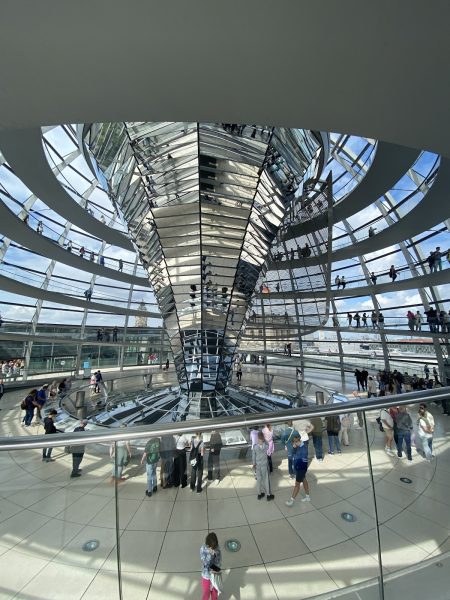
(Sidney Lin)
More than just the building’s history, it is in fact this unique dome that makes the Reichstag one of Berlin’s most popular attractions, drawing in three million tourists per year. A curved walkway lines the inside edge of the dome, all the way to the top, allowing visitors to climb toward the sky and experience panoramic views of the entire city.
Despite the breathtaking views outside, local Berliners are more concerned with looking inwards. A cone in the center features mirrors that reflect the sunlight into the legislative chamber below the dome. Visitors can look down into this chamber, quite literally over the shoulders of their legislators, representing the importance of being able to keep a watchful eye on one’s government, especially following the devastating legacy of German politics.
Tiergarten Soviet War Memorial
If you go to the right of the Reichstag’s entrance and make your way through the greenery, you’ll arrive at Tiergarten Park. A few more minutes down the trail, you’ll find yourself right behind shiny stone pillars. Though decades have passed since the construction of this Soviet War Memorial, its golden letters still gleam.
As the name suggests, this memorial commemorates the Soviet soldiers who lost their lives in the Battle of Berlin. Atop the tallest pillar, a frozen statue of a soldier stretches his hand over the 2,000 soldiers who are buried just behind the columns.
It was through this very location that Adolf Hitler had once envisioned a magnificent avenue, known as “Siegesallee” (“Victory Avenue”). Hitler imagined it would put the Champs-Élysées of Paris to shame. With the conclusion of the war and Germany’s loss, of course, these victory plans never came to fruition. However, in an act of spite and triumph, the Soviets erected their memorial right at the heart of where this avenue would have been, and close to the site of their victory at the Reichstag.
Topography of Terror & Memorial to the Murdered Jews of Europe
In spite of his vast influence on Germany during and prior to the war, surprisingly few of the original symbols of Hitler’s power stand today in the city of Berlin. In fact, the German Federal Ministry of Finance – the former headquarters of the Luftwaffe, the Nazi Air Force – is the only major building formerly under Hitler’s control that survived bombing.
But make no mistake, the solemnity of this horrifying chapter in history is still documented at various points throughout the city. Just down the street from the ministry is the Topography of Terror, a pensive yet captivating museum that chronicles the evils of the Nazi regime. The exhibit contains dozens of primary sources, photographs, documents, and secondary information to delineate these horrors that can never be forgotten.
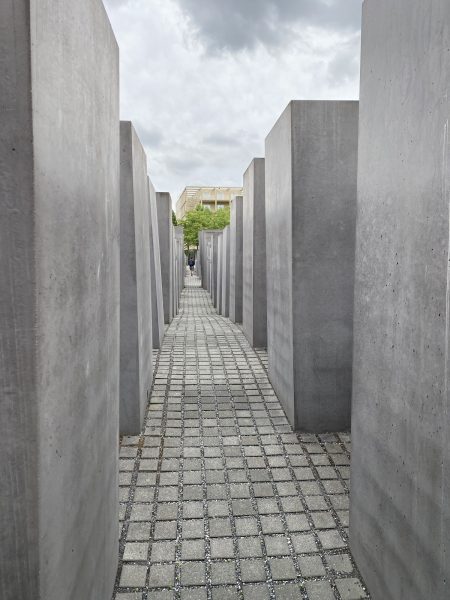
While incredibly compelling on its own, perhaps the most striking aspect of the museum to keep in mind while visiting is that it is built upon the remains of the former Gestapo building, the main base for the Nazi secret police. Like so many other locations in Berlin, the transformation of this spot is astounding. Once Berlin’s most feared address to set foot in, a visit to the city is now incomplete without it.
A more symbolic commemoration of the tragedy of this era is just a fifteen minute walk north. The Memorial to the Murdered Jews of Europe was the first Holocaust memorial sponsored by the German government. The memorial is chilling, with rows and rows of gray pillars that seem to resemble gravestones. Another interpretation is that the dizzying and disorienting nature of the memorial reflects the loss of reason, even in a supposedly ordered political system. In any case, visitors are encouraged to derive their own meaning from this memorial, or simply ponder this grave moment in world history while weaving through the many stone blocks.
Berlin Wall
Strolling through East Berlin today, it’s almost impossible to imagine that this was once the decimated neighborhood separated from the Western-controlled prosperous half of Berlin.
When I visited, I was more than at ease as I marveled at the picturesque streets, soaked in the cheerful energy of dining al-fresco, and peeked into the trendy cafes. But, East Berlin certainly was not a place of such content just a few decades ago.
In fact, it took a wall built in 1961 to keep people in the Soviet-occupied German Democratic Republic — which in Berlin, meant the city’s east half. For twenty-eight years, hefty cement blocks divided Berlin, and thousands of people from the east side attempted to flee to the west. Many were driven by the food shortages, poor living conditions, and economic hardships of the east; others felt opposed to living in a Communist country. Whatever the motive, making it out of East Berlin was not easy. Often a matter of life or death, these perilous circumstances forced many to be creative with their escapes.
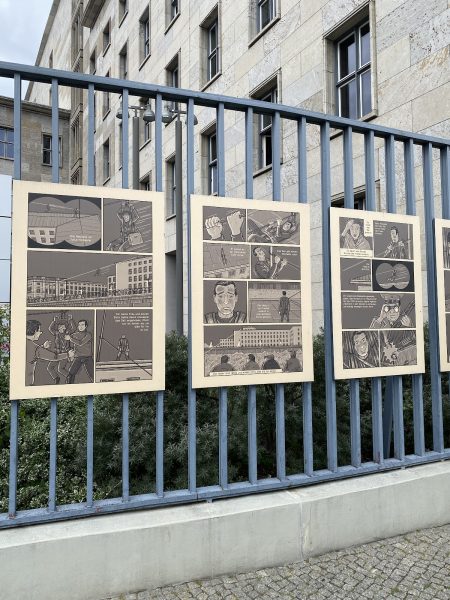
One notable example comes from the Holzapfel family, who attempted to flee West in July of 1965. Today, this family’s daring flight for freedom is memorialized by a short comic by artists Susanne Buddenberg and Thomas Henseler. A physical copy of this comic’s panels hangs on the gate just a block east of the Topography of Terror. The sketched pencil brings to life the emotions of fear, danger, hope, and ultimately relief.
Having lost their faith in socialism and the GDR, on a pitch black and windy night, Heinz Holzapfel, his wife Jutta, and their 9-year-old son Guenter undertook the greatest risk of their lives. Carrying just a makeshift zipline, and with a few loved ones on the other side, they began their journey. When the coast was clear of guards, the three snuck up to the roof of the House of Ministries, where they stood almost 80 feet above ground, and 25 feet horizontally from freedom.
The family threw a thick steel cable down to the other side of the wall, where it was tied to a truck and pulled tight by Heinz’s brother-in-law, aiding them in the escape. Up on the roof, the other end of the cable was tied to a flagpole, creating a rope to zip down. A bicycle wheel was placed on the rope and fastened to a waist harness. The only thing left to do was jump.
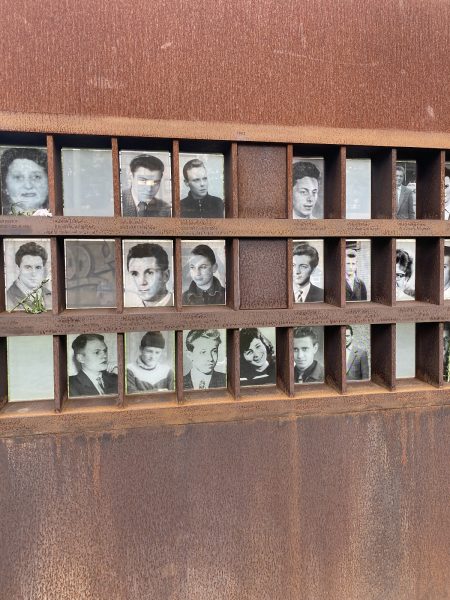
Guenter Holzapfel went first; his parents held their breath as they watched their young son, camouflaged into the night with soot, slide through the air toward safety. Jutta was next, and although bruised from the landing, she too made it to the other side.
Finally, only Heinz was left. However, there was no one left to lift the cable up the flagpole and provide space to hook on the line and slide down. The line hung too low for him to make his way past the roof’s edge. For over an hour, it seemed as though freedom was just out of reach. Finally, Jutta, watching from the ground, realized the issue. She loosened the cable on their end, and Heinz was able to lift it up enough to make it down, reuniting with his family for their new life.
For more in-depth on the history of the Berlin Wall itself, the Berlin Wall Memorial is a must-see. You can take the opportunity to cross the river Spree and walk along Bernauer Straße, the road that acted as the border of the wall. The memorial spans almost a mile, with graffitied rubble as its backdrop and informational posts in both English and German. The memorial also commemorates the many who died trying to cross the wall with names and photos. It is a solemn sight, especially seeing the faces of the young children who were lost in this time of Berlin’s strife.
Checkpoint Charlie
By far, the most famous border crossing between East and West Berlin was Checkpoint Charlie. This was the only crossing by which foreigners, including Allied officials, were permitted to enter East Berlin. U.S., French, and British military personnel were often stationed here for easy access to the other side of the border. To symbolize this divide between sides, a large image in the middle of the street now features the solemn gazes of an American soldier facing East and a Soviet soldier facing West.
This was also the sight of reunification. In 1989, after a government official misspoke during a press interview, the city’s residents were misinformed that the long-despised travel restrictions in Berlin would be terminated immediately. In response, thousands of East Berliners gathered at the gates of Checkpoint Charlie, screaming for freedom and to be reunited with their fellow countrymen in the West, who had collected on the gate’s other side. Following hours of protest, the border guards finally relented, opening the gates, and unifying Berlin once and for all.
The most recognizable aspect of the Checkpoint Charlie may be the large sign, which alerts all who approach on the West side of the border that they are now “LEAVING THE AMERICAN SECTOR,” and likewise, “ENTERING THE AMERICAN SECTOR” on the East. However, the famous sign that stands now is a replica of the original. According to a local tour guide on my visit, the real sign used throughout the Cold War is stored safely “a few hundred meters away.”
Buddy Bär & A Brighter Future
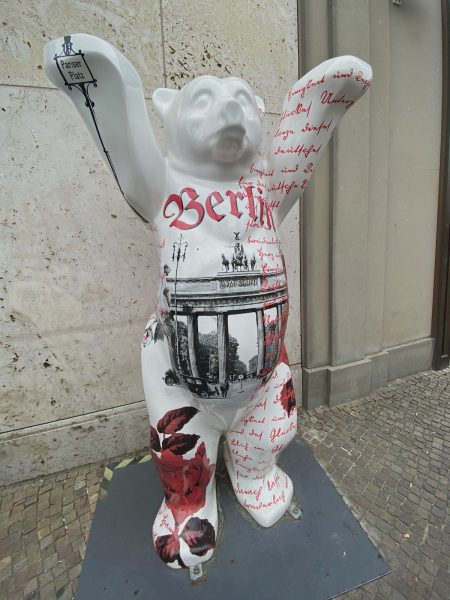
(Sidney Lin)
While the masses are drawn to these intriguing reminders of the 19th and 20th centuries, Berlin’s history is growing as we speak. This progress is exemplified no better than by the seven-foot-tall bears that roam the city. While the idea of this might be alarming, there’s no need to fear. The Berlin Buddy Bear Project was started by Eva and Klaus Herlitz in 2002 and inspired by CowParade, seen in cities such as New York City. Similar to this diverse array of colorful cows, the Buddy Bear installation features hand-painted fiberglass bear sculptures that stand on just about every sidewalk, street corner, and in front of numerous stores throughout Berlin.
Bears have long been symbols of Berlin due to the similarity between the words Berlin and “Bärlein,” meaning “little bear.” These friendly cubs provide their own spin on this tradition. They often stand proudly with their hands up, acting as symbols of unity and optimism in a city that has endured so much. On any trip to Berlin, you’re guaranteed to pass the kind faces of the Buddy Bears. A personal favorite of mine is a white bear painted with the Brandenburg Gate, which you can find along Unter den Linden, the avenue perpendicular to the gate.
Even with a somber history, Berlin refuses to be defined as a city of hardship. It is a living, breathing pillar of perseverance, strength, and a testament to rebirth. In 1963, at the height of American-Soviet tensions and just less than two years after the Berlin Wall was erected, President John F. Kennedy gave the most renowned speech of the Cold War. Entitled “I am a Berliner,” Kennedy addressed a crowd of 450,000 with powerful words, which ring just as true decades later; “Two thousand years ago the proudest boast was civis Romanus sum [‘I am a Roman citizen’]. Today, in the world of freedom, the proudest boast is ‘Ich bin ein Berliner.’”
“Two thousand years ago the proudest boast was civis Romanus sum [I am a Roman citizen]. Today, in the world of freedom, the proudest boast is ‘Ich bin ein Berliner.’”

